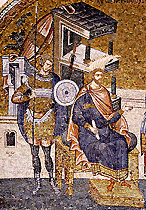 |
|
 |
Introduction
 he internal structure of Byzantine society was directly connected to the productivity
he internal structure of Byzantine society was directly connected to the productivity
 relations that prevailed in the rural areas, since the most important facet of the economy was the exploitation of the land. relations that prevailed in the rural areas, since the most important facet of the economy was the exploitation of the land.
The creation of independent states and the trend
towards a general adoption of feudal structures during the late Byzantine
period contributed decisively to the shaping of the social classes in this
period. Below the indisputable apex of the social pyramid, the Emperor,
stood the aristocracy. Its presence, markedly manifest in every area of
life, provoked the strong opposition of the lower classes, and the
antagonism between the latter and the ruling class contributed to the
image of social conflict, which constitutes a basic characteristic of the
late Byzantine state. Representative examples of the power and authority wielded by the aristocracy in all areas of life - political, economic and intellectual - are the Kantakouzenos and Metochites families.
The Church, especially the monasteries, played a dominant role in the internal structure of Byzantine society. As a matter of fact, the monasteries counted among the privileged great landowners, together with the aristocracy.
An extensive reference to the rural population,
that is to the paroikoi
and the landless or indigent workers, who
constituted the most productive and numerous element of the rural
population, is necessary in order to present a complete picture of the
social stratification of the late Byzantine period, while the soldiers and
the small class of merchants and manufacturers, who likewise had their
place in the social hierarchy, must also be mentioned.
|